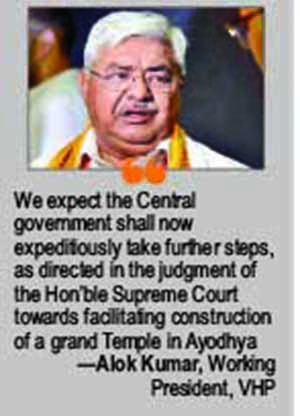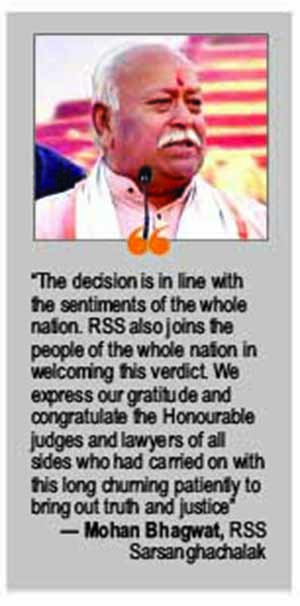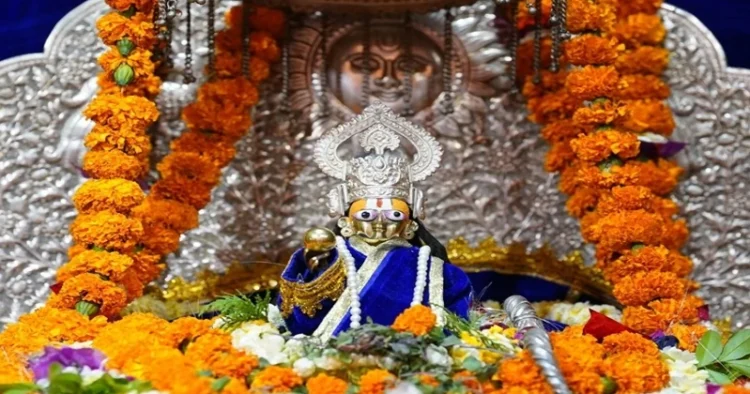Kudos to the Supreme Court’s verdict on the decades-long Ayodhya-Babri Masjid dispute for reaffirming the independence, transparency, and far-sightedness of our judiciary and for restoring people’s faith in the system. The Chief Justice of India Ranjan Gogoi-led Bench of Justices Sharad Arvind Bobde, Dhananjaya Yeshwant Chandrachud, Ashok Bhushan and S. Abdul Nazeer and archaeologist K K Muhammed, a member of the first team who carried out excavation at the disputed Babri site, deserves kudos for taking all necessary safety measures before articulating much-awaited and sensitive verdict on Ram Janmabhoomi. The Supreme Court has rightly held the rights of Ram Lalla Virajman, the presiding deity of the disputed site. Ram Janmabhoomi has been the site of religious dissent and much bitterness all through its history. In 1992, however, clashes between Hindus and Muslims escalated to unprecedented levels causing disturbances all over the country and affecting the lives of many hundreds. This Ayodhya land dispute had started in the way the way back 1853-1860. The controversy began in the year 1853 after the construction of the mosque and the Hindus alleged that the place where the mosque was built was earlier the temple of Sri Rama, which was demolished, and the mosque was constructed and Ayodhya dispute had affected almost all the sections of Indian society. It is very sad that so many lives have been lost for this and now the Indian people would finally realise that all religions should try to unite people and not divide. Hindus consider Ayodhya as the birthplace of Lord Ram. They have religious sentiments. Hindus have faith and belief that Lord Ram was born under the dome. The verdict has brought joy and relief to the people of both the communities. The way all have treated this judgment with balanced opinion keeping in view of national interests is highly appreciable.
Ram Janmabhoomi is one of the major pilgrimage centres for the Hindus of India. In Ramayana, the mythical granth of Hindus, it is said that Ram’s birthplace had been on the banks of the Sarayu River in Ayodhya town. Ayodhya has been in the middle of a dispute and controversy, since last many decades, which has only increased since late 1980s. The controversial issue of Ram Janambhoomi and Babri Masjid has always been a big influence on Indian politics for several decades. We all are aware of the fact that the disputed land at Ayodhya in Faizabad district of Uttar Pradesh has always played major role in disturbing the communal harmony of India. In a unanimous judgment, a five-judge Constitution bench of the Supreme Court gave a historic verdict in the decades-old Ayodhya’s Ram Janmabhoomi-Babri Masjid land dispute case, directing that Hindus will get the disputed land for the construction of a Ram temple while a suitable plot of land, measuring five acres, will be given to Sunni Waqf Board. In 1992, the demolition of Babri Masjid by Hindu nationalists gave birth to widespread Hindu-Muslim violence. Archaeological excavation has indicated the presence of a temple under the mosque’s debris. According to the reports from 2003, the Archeological Survey of India has found proof of the Ram temple’s existence predating the mosque at this site.
Key takeaways from the Ayodhya verdict
In its 1045 pages long judgment by the 5 judges bench headed by Chief Justice of India, His Lordship Ranjan Gogoi and comprising by four other lordships viz. Justice S A Bobde , Justice D Y Chandrachud, Justice S Abdul Nazeer, and Justice Ashok Bhushan, the Constitution Bench, that was set up on January 8, 2019, heard the case for over 40 days from August to October, delivered the judgement on November 9, 2019
- The SC has ordered the Union Govt of India to set up a trust to build a temple on the Ram Janmabhoomi Site, while allotting alternative five acres of land for constructing a mosque in a suitable place in Ayodhya.
- The apex court has directed the Centre to formulate a scheme pursuant to the powers vested in it under Sections 6 and 7 of the Acquisition of Certain Area at Ayodhya Act 1993. The scheme shall envisage the setting up of a trust with a Board of Trustees or any other appropriate body under Section 6 who will undertake the construction of a Ram temple at the disputed structure site discarding the Mosque claim on that site on the ground that the Muslim sides failed to prove their title of possession there anyway.
- The SC has allotted the entire 2.77-acre disputed land to the Hindu sides for temple construction, refuting the one third sharing formula for all to Ramlalla Virajman (Bhagwan Ram existing in the Childhood form), the Nirmohi Akhada and the Sunni Wakf Board as settled by the Allahabad High Court earlier in 2010. The apex court clearly said that the three-way bifurcation by the High Court was legally unsustainable. Even as a matter of maintaining public peace and tranquillity, the solution which commended itself to the High Court is not feasible. The SC also said that dividing the land will not subserve the interest of either of the parties or secure a lasting sense of peace and tranquillity.
- The SC also ruled that the Nirmohi Akhara suit was not maintainable and it has no shebait rights (priestly rights). However, the court directed that in the Board of Trustees, the Nirmohi Akhara should be given fair and appropriate representation.
- The allotment of land to the Muslims is necessary because though on a balance of probabilities, the evidence in respect of the possessory claim of the Hindus to the composite whole of the disputed property stands on a better footing than the evidence adduced by the Muslims.
- The claim of Shia Waqf Board against Sunni Waqf Board to Babri Masjid was also dismissed+ by the apex court out-rightly mentioning the ‘inordinate delay of 24964 days’ to file the case by the Shia Borad in the case SLP (Civil) Diary No.22744/2017 Shia Central Board of Waqf U P…Petitioner -Versus- Sunni Central Board of Wakf …Respondent.
- The SC said that archaeological evidence cannot be brushed aside as conjecture and hypothesis. SC held that Archaeological evidence supports that the Babri Masjid was not constructed on vacant land but on a definite non-Islamic structure. However, Archaeological Survey of India findings did not say whether a particular Hindu temple was demolished to construct a mosque in 1528 by Mir Baqi, the lieutenant of Mughal ruler Babur.
- The court also said that the destruction of the mosque in 1992 happened in breach of SC orders. The desecration of the mosque by placing idols in 1949 and its demolition was contrary to the law, it added.
- The SC also recognised the Muslim invasion over the Hindu worship place by stating that the Mosque was not built on the plain land and there was an existence of un-Islamic structure beneath, but expressed inability to determine whether it was done by destructing the Rama Janmabhoomi Temple that was existing since the twelfth century.
- Besides this unanimous judgement, one of the judges also seriously attempted to clear the doubt on the Hindu faith Whether disputed structure is the holy birth place of Bhagwan Ram as per the faith, belief and trust of the Hindus, in its 115 pages long ADDENDA in its verdict under a caption “Whether disputed structure is the holy birth place of Lord Ram as per the faith, belief and trust of the Hindus?
The political parties also deserves praise for respecting the verdict of the Supreme Court in the Ayodhya case and also for appealing to all the parties concerned and to all communities to abide by the secular values and spirit of fraternity enshrined in our Constitution and to maintain peace and harmony. This is the historic day for India – the largest democracy in the world that saw the end of a dispute spanning several centuries which had pitted the Hindu and Muslim communities against each other in the courts. History books clearly establish that there was a temple and it is the unshakeable faith of believers that this is the birthplace of Ram which itself is the greatest evidence. It is nice that at last the temple justice has resolved the decades old case amicably.






















Comments